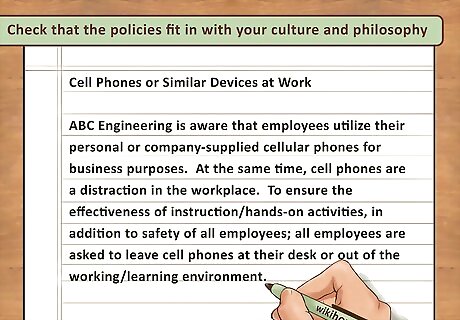
views
Starting Your Management Plan

Determine the need for a management plan. The management plan serves the purpose of formalizing the procedures and policies crucial to your organization and the responsibilities and authorities of everyone involved in running it. Without a plan, your operations may be inconsistent, responsibilities might be unclear, and the organization may be unprepared for certain events. A management plan allows everyone in the organization to clearly see their place, including who they report to, who reports to them, and the responsibilities of their position. Defining roles also creates accountability by making it clear who's fault it was that something did or did not happen.

Outline your plan. Your management plan will have to contain a number of key elements. Create a simple outline, perhaps on a whiteboard or word processor, that shows the parts of your management plan so that you and your team can move through them. Your plan should include the following sections: A description of management structure. A section detailing management members and their responsibilities and authorities. A chart of section detailing interactions between and responsibilities of each level of the organization. A section explaining different aspects of your organization being managed and the policies and procedures of that management. A schedule for updating, enhancing, and growing management and the management plan.

Describe your management structure. Each organization or business has a slightly different management structure. At the start of your plan, outline clearly with words or diagrams your management structure. Identify who makes the final decisions, whether it is management, a board, or one person. Include external and internal decision-makers and consultants. If necessary, explain how decision-making is allocated to different levels of the hierarchy.

List different aspects of your organization being managed under the plan. Divide up all of the processes and functions being managed as part of the management plan into categories. These categories may be different departments in a large business or business processes in a small one. Common aspects of operations might include managing employees, overseeing finances, controlling inventory or supplies, marketing or public relationships, and operations (like manufacturing or sales). Split up the different aspects of your organization so that you can define management roles and procedures for each.
Describing Ownership and Management

Note what type of ownership policies are in place. Describe your company's ownership in clear terms. You should distinguish if it is a public, private, or non-profit organization. Furthermore, if there are multiple owners or investors, you may need to indicate how authority, liability, and stock are distributed. For example, ownership might be divided in a partnership agreement or to holders of stock in the company.

Name your board members. If your business has a board, you should clearly identify its members. Write a brief summary of their leadership capabilities, past experiences, strengths, and weaknesses. Small private business will probably not have a board of directors. You do not need to include this section if you do not have a board. Include a copy of board policies, including election policies, term length, responsibility, authority, and conflict resolution. This information should already be stated in your operating agreement or other founding documents.

Introduce the key management members. Present each member's qualifications and experience. In addition to your owners and board members, this may include investors, executives, managers, important employees and staff, and entrepreneurs. Layout the background of these members, along with their characteristics and how each will contribute to the success of the business.

Present the strengths of each individual in the management team. Describe how these qualities are valuable to the positions that each manager holds. Include attributes such as motivational skills, financial talents, and business proficiency. List past positions and duties of each member that apply to their current management obligations. Explain how these obligations highlight applicable skills and strengthen the management positions. Highlight all relevant educational backgrounds for each of the managers. Explain how their training will benefit the company. Only include the education that is relevant to the positions that they currently hold. If you are the only employee in your business, be sure to include your own experience and strengths.

Describe the hiring process. Explain the basis on which new employees will be hired. Mention what kind of qualifications and experience is needed for each role.This is especially important if you have not hired any managers yet. Include the training process and any incentive or reward programs you have implemented. A description of the company's benefits program can also be added.

Name any outside consultants or advisors you will be hiring. These are the people that you may contact for marketing, personnel advice, and financial knowledge. For example, your business might hire: Lawyers. Accountants. Insurance brokers. Consultants.

Summarize your management team's abilities. Write a short summary of why this is a successful team. At the end of the management plan, you should specifically state why this team will ensure success for the business. Clearly identify how this combination of managers within this particular business model will help your business in the coming years. This should tie up all the various points of your plan. For example, “Our team, with its diverse array of skills, have a combined forty years of experience in this field. With our coordinated democratic structure, they can work together effectively to produce results. With this team, we are confident that our business will become profitable in two years.”

Describe relationships between management, ownership, and employees. A key aspect of your management operations will be interactions between management levels and between management/owners and employees. Make clear the authorities, responsibilities, and roles of each level for each aspect of operations. Include processes for shared decision-making and collaboration, along with any required meetings or lines of communication. Work with each level to make sure everyone is on the same page when it comes to resolving disputes and sharing power.
Writing Out Policies and Procedures

Consider your need for written policies. Written policies serve the purpose of formalizing operations across a large organization. They create consistency and make sure that all processes run smoothly. However, a very small business or organization may have no need of such a set of policies. In fact, defining them in this way may limit collaboration and slow down work for a small group. Think about the size and needs of your organization before taking the time to define policies.

Gather a group of relevant management members and employees. For each aspect of operations considered, gather a group of management and employees who are directly impacted by or responsible for that process or area. Work on defining the policies and procedures for that area with the group, taking input and confirming details as you go. This will allow for the plan to be grounded in real operations and will give your employees a sense of ownership in the plan.

Write out policies and procedures for each aspect of the business. These will be used together to tell your management and employees how to operate a given section of the organization. Policies, the philosophy and rules of your organization, are designed to further your goals and keep your operations true to the organization's principles. These policies are expressed through your procedures, which are specific methods for how things are to be done. For example, a policy might be using and selling only green materials and products. The procedures to support that policy might be shopping from approved green vendors or checking the environmental impact of each material or product used.

Check that the policies fit in with your culture and philosophy. Your policies, and by extension your procedures, should be designed in line with your overarching philosophies and goals in mind. Check over each one that you've created to make sure that they are all working together towards the same end. If some do not seem to fit or you find some questionable procedures, amend them to better fit your mission.
Revising Your Plan

Proofread your plan carefully. You want your management plan to look professional. It should be free of spelling and grammatical errors as well as any typos. It should be printed on white paper that is unwrinkled and free of stains.

Format your plan for clarity. The formatting of the management plan should be the same as the rest of your business proposal. You may choose to mark off major sections with bold headings. The font should be readable. Times New Roman font at 12 point size is standard. You can use bullet points to list experience, abilities, and responsibilities, or you can have short paragraphs providing all of the essential information.

Consider asking a business consultant to look it over. The more people who read your plan, the better. A business consultant or financial planner will be able to provide better advice once you have a draft of your management plan than before. Sit down with the consultant. They may be able to identify any holes or conflicts you have in your business plan.

Send it out to all owners. It is important that all owners and high level managers of the company agree on the management plan. Make sure that each owner has a copy. They may send you edits and revisions. Consider these carefully. If you disagree with any of their changes, sit down with them so that you can find a compromise for your business. When they approve, have all owners sign the plan before you submit it to your investors, bank, or fundraising bodies.

Make a commitment to amend your plan as necessary. Any management plan you create will be untested and will likely need revision as you begin to implement it. Therefore, you'll need to include provisions by which the plan can be amended and revised throughout its life. Start by creating a schedule for assessment, stating times at which a group will meet to discuss the effectiveness of the plan and the success or failure of its implementation. Make sure there is a way for all management and employees to submit their feedback regarding the plan. Then, create a method by which changes to the plan can be approved and instituted.



















Comments
0 comment